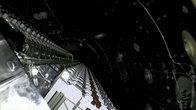The first batch of satellites were launched from Cape Canaveral, Florida, and deployed to orbit by a Falcon 9 rocket on May 23. Each contains a single solar array, which both captures and bounces sunlight off the satellites and, as a result, can sometimes be seen from Earth. On May 25, as the drifting luminescent army of satellites zoomed overhead, Dutch satellite tracker Marco Langbroek captured their marching, posting a stunning video to Vimeo.
In time, the satellites will drift apart and head to specific orbits so that satellite internet coverage can be beamed to every corner of the globe.
However, as the unusual display in the night sky quickly gathered steam across social media, some astronomers began to point out the potential problems the satellite system may pose for astronomy. At present, only 60 satellites are moving into their orbit, but eventually that number will reach 12,000, and a megaconstellation will encircle the Earth. Practically overnight, our view of the sky has changed.
“We’ve become used to change in space activities as slow and incremental, and suddenly, it’s fast and speeding up,” said Alice Gorman, space archeologist at Flinders University, Australia. “By its very visibility, Starlink has opened up some big questions: who gets to use Earth orbit and what for?”
Indeed, Starlink would triple the number of satellites orbiting the Earth. If thousands of satellites are sent into orbit, our view of space changes. Will we find ourselves in a position where it’s impossible to investigate the cosmos from the ground?
The quick answer: not forever, no. SpaceX designed the Starlink satellites to fall back to the Earth after about five years of service..
“The satellites are meant to put themselves in a re-entry orbit at the end of their mission life, and remove themselves from the debris population by burning up,” says Gorman.
But the long answer is: potentially. Astronomers already wrangle with the problems posed by space robots and satellites circling the Earth whenever they turn their ground-based telescopes toward the stars. Bright, reflective surfaces pose a problem because they obstruct our view of the universe.
More satellites equals cloudier vision, and Starlink plans to launch more satellites than ever.
When the sun is reflecting off the satellites’ solar panels, astronomers will have to account for the appearance of the satellites in their images. SpaceX was relatively mum about the design of the satellites leading up to launch, so it’s come as a bit of a surprise to some astronomers just how bright they are. However, the satellites will position their solar panels as they establish themselves in orbit, which should reduce their brightness.
Jonathan McDowell, an astronomer with the Harvard-Smithsonian Center for Astrophysics, perhaps summed it up best in a tweet, saying the satellites are “brighter than we had expected and still a problem, but somewhat less of a sky-is-on-fire problem.”
“Somewhat less of a sky-is-on-fire problem” sounds slightly reassuring, at least. But there do seem to be clear issues for the astronomy community..
Elon Musk, SpaceX CEO, jumped to the defense of his satellite system and noted on Twitter how “potentially helping billions of economically disadvantaged people is the greater good,” while making it clear that SpaceX plans to limit Starlink’s effects on astronomy. “We care a great deal about science,” Musk tweeted. He said he’s sent a note to the Starlink team to reduce albedo — that is, the amount of light the satellites reflect.
In addition, after a user suggested placing space telescopes using Starlink chassis into orbit to appease the astronomers, Musk said he “would love to do exactly that.” That might ease concerns, but will it slow our quickening colonization of Earth’s orbit? Unlikely.
“Space agencies and organizations have been cluttering the sky for decades and taking a very lax attitude to the long-term consequences,” said Gorman.
With a number of satellite constellations on the way, it will be critical for regulatory bodies and satellite providers to adequately manage the space debris and satellite problem, lest all of our space robots collide and lock us on Earth forever (yes, that’s a faint but possible catastrophic scenario)
Source: SpaceX Starlink satellites dazzle but pose big questions for astronomers – CNET

Robin Edgar
Organisational Structures | Technology and Science | Military, IT and Lifestyle consultancy | Social, Broadcast & Cross Media | Flying aircraft

